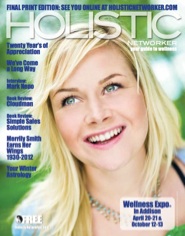How Food Additives Slip Into Your Diet and What To Do About It: Part 1
by Allie Chee
There are tens of thousands of food additives, some growing in your backyard, and some only derived from chemical processes having nothing to do with a food’s natural state. The makers of food additives and food processors are increasingly clever in how they manipulate and name these additives, which means toxins continue to slip into your diet—often unbeknownst to you.
In part one of this two-part series, we will discuss types of additives and focus on a controversial group of MSG-containing additives. In Part 2, we will discuss how these additives made their way into top-selling organic products, onto the shelves at health food stores, and into your kitchen.
Monosodium Glutamate, aka MSG! Autolyzed yeast extract! Hydrolyzed vegetable protein!
In the world of nutrition, those are fighting words. Few common food additives come under the scrutiny and raise as much argument as these. Producers and groups of scientists say concerns about these additives are unfounded and the people concerned are phobic. Other scientists and an enormous group of consumers supply opposing research and consider the additives toxic poisons and the producers a public health menace.
However, before we delve into the details of this Japanese discovery that took the processed food industry by storm, let’s discuss additives in general.
Three Groups of Food Additives
With the truly natural additives, meaning those that a knave with the simplest of tools could gather: sea salt, a sprig of rosemary, cinnamon stick, and Madagascar vanilla beans, for example—few people will question the source or take up arms regarding the reason for or the side-effects of adding those ingredients to food.
With the group officially titled “artificial” additives—those concocted with a savory melange from the Periodic Table (i.e. small pinch of lead, tiny splash of mercury)—there is also little debate about the issues related to their use (at least there is little debate in holistic health circles).
The details of the artificial additive group are often proprietary trade secrets and are summed up as “artificial flavor” on the ingredient list. Those additives can be determined safe for human consumption (in certain quantities, mind you) by government agencies (the same government that allowed for negative amortization loans? It’s buyer beware, baby!) and the companies that sell them; but anyone conscious about what goes in their body would probably skip the debate, place their bets elsewhere, and simply avoid products containing them.
Then there is the third group of additives—those that cause more confusion and indigestion than efforts to predict the current movement of the Dow Jones: the legally-natural additives.
The argument used with great frequency by those benefiting from the use of controversial, “natural” food additives is: they are naturally occurring in foods we eat. However, if you pause to ponder, the next questions that may pop in your mind could be:
• In what proportion and quantity are they found in those natural sources and are they added to other foods in those exact proportions?
• Are there complimentary elements in those natural sources that help negate potential negative side-effects, prevent absorption, etc.?
• Just because it is found naturally occurring in foods, does that we mean should consume extra servings of that ingredient? Many poisons are found naturally occurring in foods. Amygdalin, for example, a cyanide and sugar compound that degrades into hydrogen cyanide when metabolized, is found in apple seeds.
• The body can metabolize and detoxify very small doses of certain naturally occurring poisons. But do we want to sprinkle an extra dose of them on our oatmeal every morning?
And finally, most poignant,
• In what manner are they isolated and does that change the effect they have on the body versus
consuming them in their truly naturally occurring state?
When first used in Japan, a primary source of glutamate in foods was a broth prepared by boiling kombu (a sea vegetable). That is not at all how the chemically derived MSG and MSG-containing foods found in processed foods are prepared in factories today.
• What is the purpose of isolating these “naturally occurring elements” from their truly natural state and adding them to foods in which they do not occur naturally?
Deciphering the answer to that question will not qualify us for Mensa; and even those of us who were held back in the first grade can take a pretty good stab at it. But for those with a shadow of a doubt, here it is. “Natural flavor” and artificial flavors are added to food that is otherwise lackluster at best, or nasty in appearance and foul in flavor at worst, so that it is rendered acceptable or even titillating to the senses (think “jonesing for another bag of BBQ flavored cardboard”), and in the hopes that we will buy it by the train-load, which we do.
This site has a wealth of information about monosodium glutamate.
www.truthinlabeling.org/hiddensources.html
No MSG (60 Minutes)
This is a 1992 rebroadcast of a story on monosodium glutamate that “60 Minutes” first aired in November 1991.
www.tinyurl.com/nomsg
A Moving Target
So let’s say you’re a person who is not fond of purposely digesting toxic chemicals and commonly known allergens, even in minute doses. Does simply shopping at a “health food” store offer sufficient protection? Does buying certified organic products protect you? What about ordering just a salad in fast-food restaurants?
For answers to these questions and a surprising look at how controversial food additives end up in places you’d least expect them, read Part 2 of this article in your next issue of the Holistic Networker.
For all articles by Allie, visit:
http://holisticnet.wpengine.com/wp/author/allie/
 Allie Chee is a Certified Chinese Medicine Nutritionist and can be contacted at: question@askalliechee.com
Allie Chee is a Certified Chinese Medicine Nutritionist and can be contacted at: question@askalliechee.com
About Allie Chee
Allie is a certified TCM Nutritionist and author of New Mother: Using a Doula, Midwife, Postpartum Doula, Maid, Cook, or Nanny to Support Healing, Bonding, and Growth











1 Reader Comment
Trackback URL Comments RSS Feed
Sites That Link to this Post